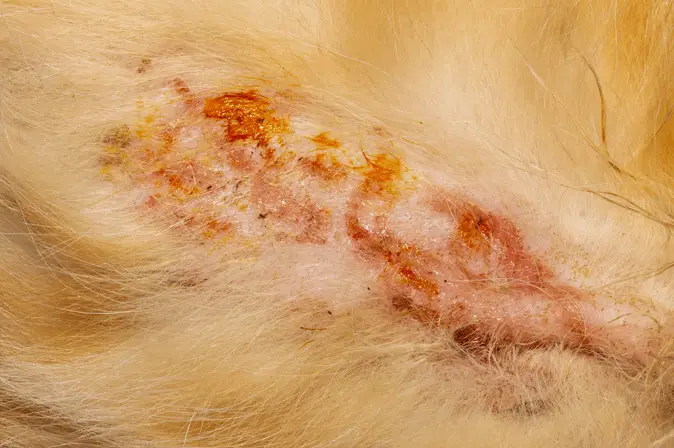Pyoderma in Dogs - Causes & Treatment
10.11.2021.
Pyoderma in dogs is one of those conditions that look a lot worse than they actually are. If you notice your dog’s having skin problems, it might be pyoderma. If you’re worried about this illness, you will be glad to hear that it’s not actually that dangerous. It can be easily treated with the proper medications. However, as a dog owner, it is entirely natural you are worried and want to know more about this health condition. Here’s what you should know about pyoderma in dogs.
What is pyoderma in dogs?
Pyoderma in dogs is a skin infection. More precisely, it is a bacterial skin infection that can be caused by different reasons. Most commonly, pyoderma develops as a secondary infection to allergic dermatitis. Pyoderma is also called impetigo, especially when young puppies get it. The literal translation of the word “pyoderma” means pus in the skin. That is precisely what a pyoderma is.
How to notice pyoderma in dogs?
If you’re not entirely familiar with what pyoderma is, your first contact with it can be stressful. It looks terrible, and the easiest way to spot it is if you notice small red bumps with a white, pus-filled center. However, that is not the only way to notice pyoderma in dogs. The best thing would be to know all the symptoms.

Symptoms of pyoderma
If you’re worried about your dog and you notice changes in their skin, there is a chance your dog has pyoderma. The best thing for your dog is you notice the symptoms early and start the treatment as soon as possible. The most common symptoms of pyoderma in dogs are;
- Itchiness
- Hair loss
- Scaling, flaky skin
- Redness
- Bad skin odor
- Excessive skin licking
- Dandruff
While most cases of pyoderma include red, pus-filled bumps, it is a good idea to know other symptoms as well.
Can the dog infect me with pyoderma?
The good news is that pyoderma is not contagious. However, if pyoderma is caused by scabies, that can be contagious to humans. The better question is can your dog infect other dogs or pets in your home. Again, the correct answer will depend on the exact pyoderma cause. If it is caused by fleas or ticks, they can infect your other pets and cause pyoderma.
What causes pyoderma?
One of the most important things dog owners want to know about pyoderma is - What causes it? Naturally, if your dog got infected once, you’d like to prevent them from getting reinfected. That means we have to understand what the possible causes are. Only then can we avoid them.
The bad news about this health condition is - it can happen for many different reasons. Most pyoderma cases in dogs are a result of a secondary infection. For example, if your dog has allergies, they will be itchy and their immune system will be off. When dogs are itchy, they scratch themselves. That can lead to tiny wounds, which is more than enough for bacteria to penetrate your dog’s natural skin protection. Here are the most common causes of pyoderma;
- Parasites
- Diabetes
- Bacteria
- Fleas
- Allergies
- Cushing’s disease
- Anatomical problems
- Some forms of cancer
- Hypothyroidism
Some of these problems will cause pyoderma as a secondary reaction. Some will cause it as a primary problem.
How can vets diagnose it?
Your vet most likely has a lot of experience with skin issues in dogs since they are fairly common. A detailed look into your dog’s medical history, existing conditions, and symptoms will give your vet enough information to suspect pyoderma. However, in some complicated cases, vets can perform these tests;
- Blood tests
- Skin cytology
- Skin cultures
- Antibiotic sensitivity tests
- Fungal cultures
- Allergy tests
How is it treated?
The majority of pyoderma cases are treated with antibiotics. Of course, antibiotics are only effective against bacterial infections, and bacteria are responsible for most pyoderma cases. In milder forms of the illness, vets usually prescribe amoxicillin, clindamycin, or cephalexin. However, in severe pyoderma cases, the vet will ask for skin culture and antibiotic sensitivity tests. It is the only way to ensure they are using the best antibiotic for the specific type of bacteria causing pyoderma. The average treatment will last 3 - 4 weeks, but severe cases can demand treatment for 12 weeks with a stronger antibiotic like Baytril.
VET TIP: Just because your dog shows signs of clinical improvement doesn’t mean you should stop the antibiotic course. It is crucial you listen to your vet and make sure your dog finishes the whole treatment.
What is the prognosis?
As we said at the beginning, pyoderma is one of those illnesses that looks worse than it actually is. The first time you notice red pus-filled bumps on your dog’s skin, you will be shocked and worried. However, you should know that the prognosis for pyoderma is excellent. Most cases are resolved with oral antibiotics. Severe cases might require more testing to confirm underlying conditions that might be causing pyoderma to return.
World Dog Finder team







Share